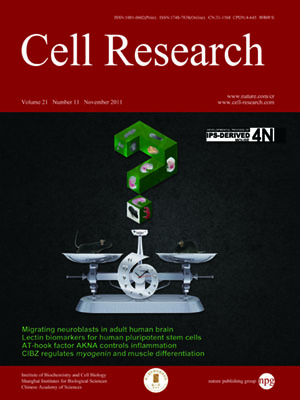
Volume 21, No 11, Nov 2011
ISSN: 1001-0602
EISSN: 1748-7838 2018
impact factor 17.848*
(Clarivate Analytics, 2019)
Volume 21 Issue 11, November 2011: 1551-1563
ORIGINAL ARTICLES
Specific lectin biomarkers for isolation of human pluripotent stem cells identified through array-based glycomic analysis
Yu-Chieh Wang1,2, Masato Nakagawa3, Ibon Garitaonandia1,2, Ileana Slavin1,2, Gulsah Altun1,2, Robert M Lacharite1,2, Kristopher L Nazor1,2, Ha T Tran1,2, Candace
1The Scripps Research Institute, Department of Chemical Physiology, La Jolla, CA 92037, USA
2The Scripps Research Institute, Center for Regenerative Medicine, 10550 N. Torrey Pines Rd., SP-3021, La Jolla, CA 92037, USA
3Center for iPS Cell Research and Application (CiRA), Kyoto University, Kyoto, Japan
4Institute for Integrated Cell-Material Sciences, Kyoto University, Kyoto, Japan
5Japan Science and Technology Agency, Yamanaka iPS Cell Special Project, Kawaguchi, Japan
6Gladstone Institute of Cardiovascular Disease, San Francisco, CA 94158-2261, USA
7Department of Reproductive Medicine, University of California, San Diego, La Jolla, CA, USA
Correspondence: Jeanne F Loring,(jloring@scripps.edu)
Rapid and dependable methods for isolating human pluripotent stem cell (hPSC) populations are urgently needed for quality control in basic research and in cell-based therapy applications. Using lectin arrays, we analyzed glycoproteins extracted from 26 hPSC samples and 22 differentiated cell samples, and identified a small group of lectins with distinctive binding signatures that were sufficient to distinguish hPSCs from a variety of non-pluripotent cell types. These specific biomarkers were shared by all the 12 human embryonic stem cell and the 14 human induced pluripotent stem cell samples examined, regardless of the laboratory of origin, the culture conditions, the somatic cell type reprogrammed, or the reprogramming method used. We demonstrated a practical application of specific lectin binding by detecting hPSCs within a differentiated cell population with lectin-mediated staining followed by fluorescence microscopy and flow cytometry, and by enriching and purging viable hPSCs from mixed cell populations using lectin-mediated cell separation. Global gene expression analysis showed pluripotency-associated differential expression of specific fucosyltransferases and sialyltransferases, which may underlie these differences in protein glycosylation and lectin binding. Taken together, our results show that protein glycosylation differs considerably between pluripotent and non-pluripotent cells, and demonstrate that lectins may be used as biomarkers to monitor pluripotency in stem cell populations and for removal of viable hPSCs from mixed cell populations.
Cell Research (2011) 21:1551-1563. doi:10.1038/cr.2011.148; published online 6 September 2011
FULL TEXT | PDF
Browse 2035


